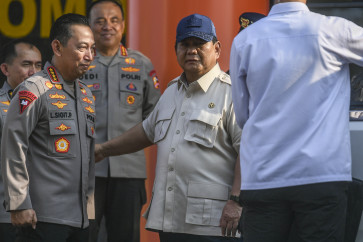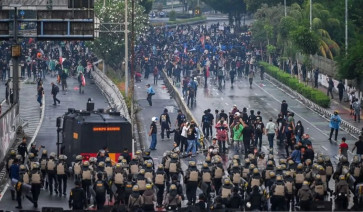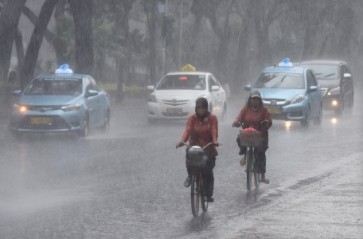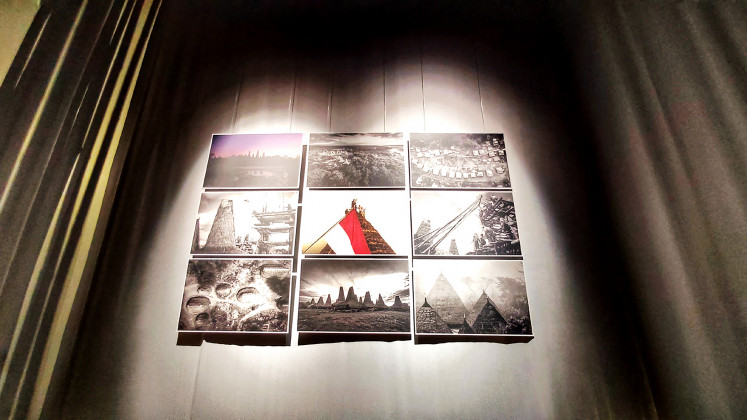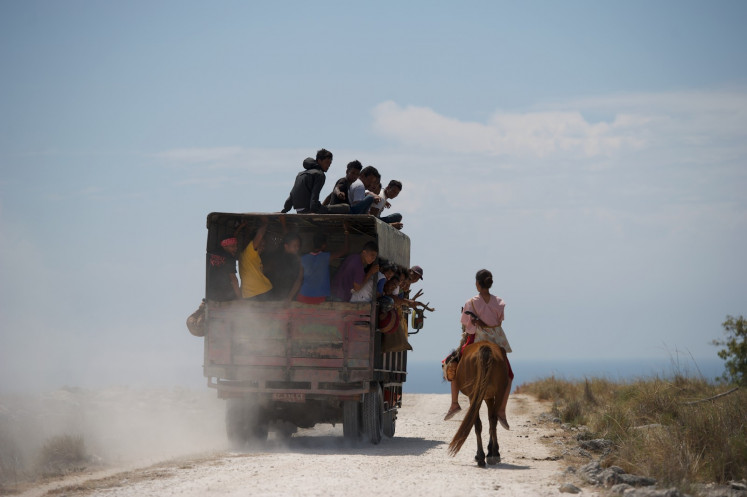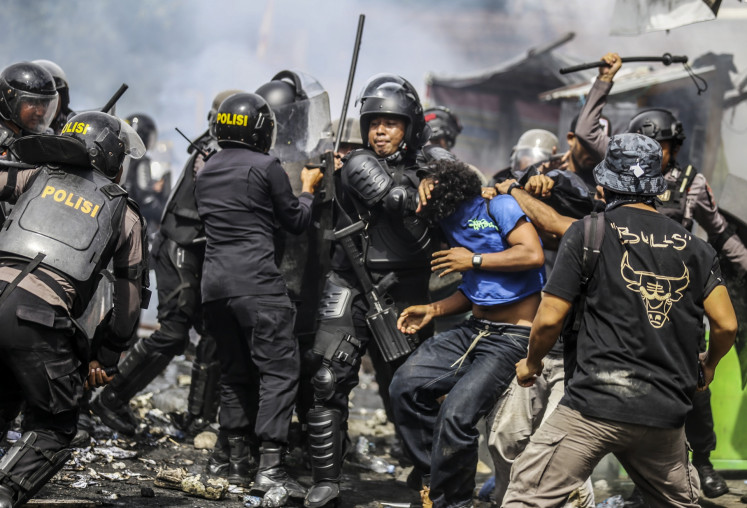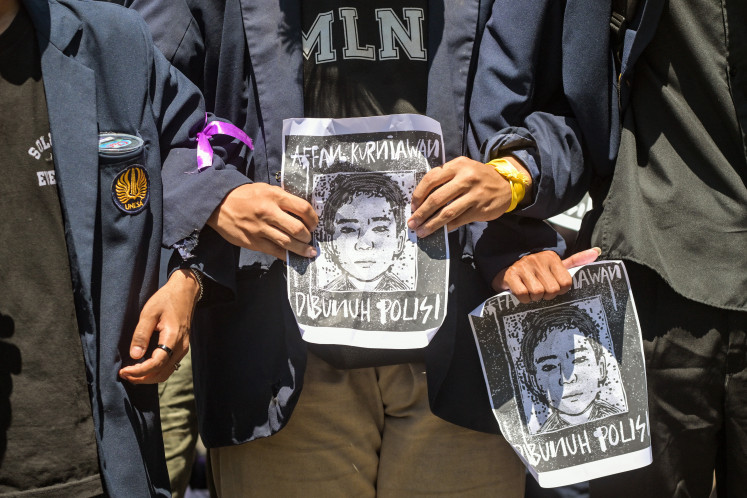Popular Reads
Top Results
Can't find what you're looking for?
View all search resultsPopular Reads
Top Results
Can't find what you're looking for?
View all search resultsColorful portrait of Padang's public transportation
Unique features adorning angkot public transportation in Padang, West Sumatra, have long been the talk of the town and beyond.
Change text size
Gift Premium Articles
to Anyone
O
n the streets in and around Padang, West Sumatra, it is common to spot groups of angkot public minivans emblazoned with colorful pictures and slogans reflecting the artistic expressions of their owners and drivers.
Minivans have also been dubbed “moving discotheques” for packing large speakers — some are even equipped with video players to play various songs, mostly of the disco music genre, although some speakers disturb the comfort of passengers who sit facing each other.
Their interiors are no less attractive, with gorgeous alterations, woodcarving decorations and fancy ornaments like puppets and dolls. Some even imitate racing cars with blasting tailpipes, while others cover their panes with dark filters purportedly to cool the inside against hot weather.
Such modifications beyond permissible limits have frequently made minivans a target of raids by personnel of the Padang Transportation Agency. But these moves have never halted the practices, with angkot owners and drivers making the excuse they have do so to attract more passengers, especially young people.
Not all public minivans in Padang share a similar look, many are content with their standard form.
Aside from the angkot, some city buses are also decorated in the same fashion despite their decreasing number as they are cornered by the authorities. Some intercity buses also follow the trend although with minimum creativity.
A portrait of Padang’s trendy and distinctive angkot has been fully depicted by David Reeve in his book, Angkot & Bus Minangkabau: Budaya Pop & Nilai-Nilai Budaya Pop (Angkot & Minangkabau Buses: Popular Culture & Popular Values), published by Komunitas Bambu, March 2017.
Believed to be the first such book in Indonesia, Reeve has succeeded in recording the phenomenon in detail.
In the book, he describes the phenomenon in a simple way and concludes the values of pop culture there. The contents of this book can even impart new knowledge to Padang residents, who travel by and watch angkot passing their city streets on a daily basis.
 Angkot & Bus Minangkabau: Budaya Pop & Nilai-Nilai Budaya Pop (Angkot & Minangkabau Buses: Popular Culture & Popular Values) by David Reeve(Komunitas Bambu/File)
Angkot & Bus Minangkabau: Budaya Pop & Nilai-Nilai Budaya Pop (Angkot & Minangkabau Buses: Popular Culture & Popular Values) by David Reeve(Komunitas Bambu/File)
More importantly, Reeve has also proven that this mode of urban transportation in Padang is the most typical in Indonesia compared with angkot and city buses in Indonesian cities that have the same culture, such as those in Malang, Medan, Bogor, Kupang, Ternate, Surabaya and Makassar.
Padang is one of the country’s most bustling cities. According to Reeve, in one location 80 minivans pass every 10 minutes. There are 23 angkot routes in the city, which is home to some 1 million people. These vehicles are distinguished by 11 main colors for certain routes.
Reeve, an Indonesianist from Australia, has frequently visited the country for the last 47 years as a diplomat, researcher, historian, language lecturer and educational project manager.
He first visited West Sumatra in 1985, but as he writes in the introduction, his attention to angkot and buses began when he went to Padang in 2006 to attend a wedding and observe public transportation there.
The book, written in Indonesian and English, also contains color photographs. Reeve discusses the interiors and exteriors of angkot. He describes the exterior adornments and classifies them into pictorial decorations and language decorations.
From language decorations, Reeve has gathered 830 words, names, slogans and phrases. The total comprises 490, 60 percent, in English and other foreign languages, 250, 30 percent, in Indonesian and 90, 10 percent, in the ethnic Minangkabau tongue.
The English words primarily indicate the pursuit of speed like the phrases “Need for Speed” and “Autocar Super Speed.” With many minivan bodies already modified, their owners and drivers have a craze for trendy racing cars.
There are words expressing grandeur like “Absolutely,” “Best” and “Kingdom,” as well as those depicting powerful occupations, strong males or soldiers. Other themes include Disneyland/city, love/partying, mother’s hopes and one’s preferences (“So what!”).
It’s also common to find Indonesian phrases with family themes, such as “Doa Ibu” (mother’s prayer) and “Anak Papa” (daddy’s child).
Positive terms include “Usaha Damai” (effort for peace) or teenage culture like “Idola Kampus” (campus idol) and “Discotic Gadis Manja” (spoiled girls’ discotheque).
Of all the phrases, Reeve found only a few of them used Islamic terminology, which is surprising given the identification of Padang and West Sumatra as an Islamic region.
He regards phrases in the Minangkabau language as having a street and colloquial tinge, with Minang words often written like English.
Besides angkot, the book also discusses city bus decorations, but the presence of trendy buses has lately decreased with the emergence of the local government’s Trans Padang project with official buses bearing no accessories. The same is true of intercity buses, which are less flamboyantly adorned than angkot.
Padang’s angkot phenomenon has come into the spotlight as a result of the free ownership of minivans by local entrepreneurs. They aren’t strongly bound by rules and dare to ignore government restrictions because they feel they have the right to the roads that originate on communal land.
Interestingly, Reeve prefers the use of “Minangakabau” rather than Padang or West Sumatra for the location of the angkot and bus operations. He apparently wants to show that the pop culture expressions arise from the ethnic Minangkabau character already well-known for its artistic flair, as evident in the carvings of rumah gadang (traditional houses) and the appealing attire of the region.
____________________________
Angkot & Bus Minangkabau: Budaya Pop & Nilai-Nilai Budaya Pop
By David Reeve
Published by Komunitas Bambu, 2017
344 pages


